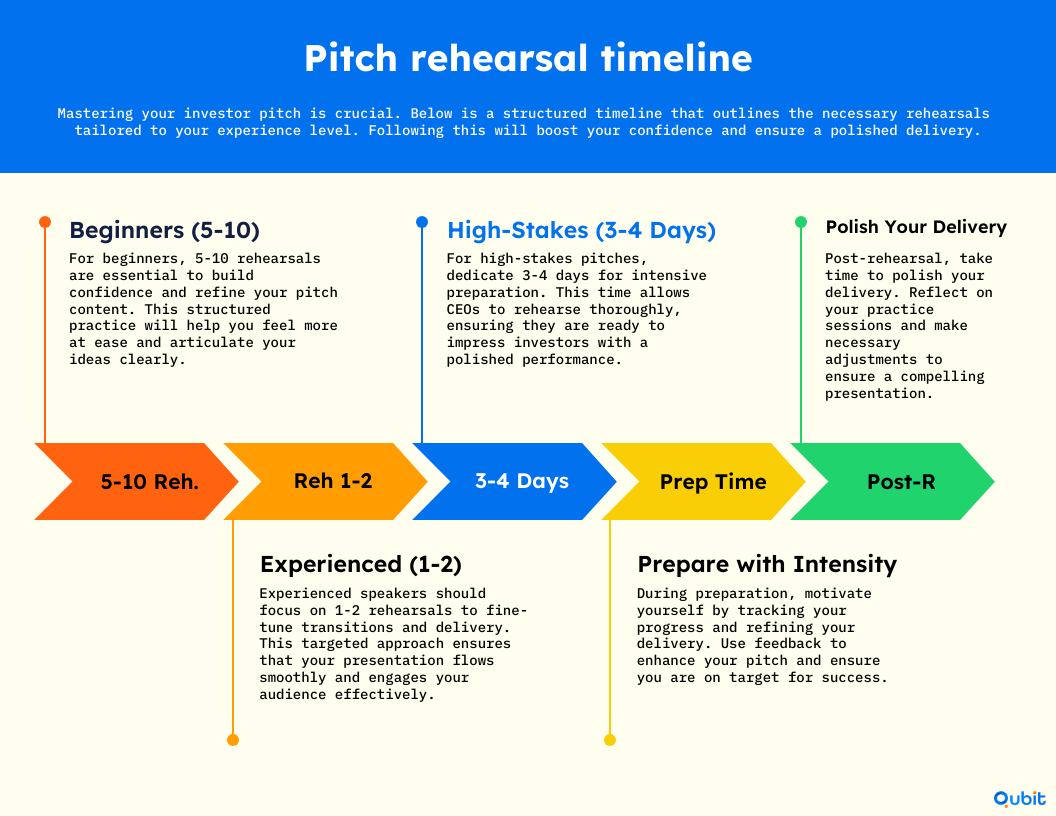Delivering a compelling investor pitch requires more than just a great idea—it demands preparation, practice, and precision. How should you practice for a speech that could determine the future of your startup? The answer lies in mastering both the content and the delivery. A well-rehearsed pitch not only conveys your vision but also builds confidence, helping you connect with potential investors on a deeper level.
Startup founders can benefit from public speaking tips for startup founders that enhance confidence and clarity, ensuring their pitch resonates with investors. By focusing on preparation techniques, you can refine your message, anticipate questions, and deliver your presentation with poise.
This article explores actionable strategies to help you rehearse effectively and maximize your chances of success.
Adaptive Rehearsal Strategies for Diverse Investor Scenarios
Crafting a compelling pitch requires a tailored approach that aligns with the unique dynamics of your startup and its target audience. Understanding how you should practice for a speech is pivotal when addressing investors across varied sectors.
Whether you’re presenting an Early-Stage SaaS solution, a Consumer Product, or a B2B Solution, adapting your narrative and data points can make all the difference.
1. Early-Stage SaaS: Highlighting Innovation Amid Limited Traction
For startups in the SaaS space, especially those in early stages, the challenge lies in demonstrating potential despite limited user traction. Focus on showcasing unique features that solve specific problems.
For instance, you might say, “We’re targeting small businesses in the e-commerce sector who need easy-to-use inventory management software, a market segment growing by 12% annually.” This approach combines storytelling with market data to emphasize opportunity. Rehearsing for this scenario means refining technical details and practicing how to connect emotionally with investors who value innovation.
2. Consumer Products: Resonating with Niche Values
Consumer product pitches thrive on personalization. Identifying a niche audience can help differentiate your offering in a crowded market. For example, “We’ve identified a 15% segment of the market that prioritizes eco-friendly products, and our biodegradable packaging aligns perfectly with their values.” This strategy underscores the importance of aligning your product with specific consumer priorities. Practice integrating personal stories or testimonials to make your pitch relatable and memorable.
3. B2B Solutions: Solving Industry-Specific Challenges
B2B pitches demand a focus on measurable outcomes. Investors in this space want to see how your solution addresses critical pain points. For example, “Our software reduces manual data entry errors by 30% in the logistics industry, where accuracy is crucial for operational efficiency.”
Highlighting tangible benefits backed by data builds trust and credibility. Rehearsal for this scenario should include synchronizing non-verbal cues and evaluating pitch performance to ensure clarity and professionalism.
Tailoring your approach to each scenario not only refines your message but also demonstrates your understanding of investor priorities. By practicing with intent and precision, you can transform your pitch into a powerful tool for securing funding.
Optimizing Pitch Deck Timing for Impactful Rehearsals
When it comes to how to practice a presentation, timing is the backbone of every successful pitch deck presentation. Investors are drawn to concise, well-paced delivery, which keeps their attention and ensures your message resonates. To achieve this, rehearsing slide transitions is essential.
Aim for approximately 6 seconds per slide during practice sessions. This approach ensures that your presentation remains engaging and avoids overwhelming your audience with excessive information.
Proper timing not only keeps your pitch on schedule but also reduces stress during delivery. When transitions flow seamlessly, you can focus on connecting with your audience rather than worrying about technical hiccups. Incorporating this strategy into your preparation helps you stay confident and in control.
Additionally, rehearsing how to handle investor questions prepares founders to address concerns with confidence and clarity.
Prioritizing Q&A for Maximum Investor Engagement
Engaging investors effectively requires more than just delivering a polished presentation—it demands creating space for meaningful dialogue. Allocating at least one-third of your pitch time for Q&A ensures that potential investors can address gaps or clarify points that may not have been covered during your main presentation. This dedicated time fosters trust and demonstrates your openness to feedback, which is crucial for building strong investor relationships.
Preparation is key to making the Q&A session impactful. Start by compiling a comprehensive list of potential investor queries. Reference the investor queries guide for insights to anticipate the most common questions investors might ask. Practicing responses to these queries not only boosts your confidence but also ensures clarity in your answers.
To maximize engagement, rehearse your Q&A session as thoroughly as the presentation itself. Knowing how should you practice for a speech is essential, as it helps you refine your delivery and maintain composure under pressure.
Crafting Essential Key Slides for a Standout Pitch
A pitch deck is more than a presentation—it’s your business’s first impression. To captivate investors, focus on crafting essential slides that act as the backbone of your pitch. Start with an overview slide that succinctly introduces your company and its vision. Follow this with a problem slide that highlights the pain points your target audience faces, creating a sense of urgency. Next, present your solution slide, showcasing how your product or service addresses the problem effectively.
Market trends are equally crucial; use this slide to demonstrate industry opportunities and growth potential. Finally, a business model slide should clearly outline how your company generates revenue. If you know how to create a pitch deck well, it serves as a compelling calling card to secure that critical investor meeting. For additional guidance, explore to ensure your presentation emphasizes key business metrics effectively.
Refer to the pitch deck appendix template for guidance for supplementary information that strengthens your pitch deck.
Clearly Articulating Your Unique Value Proposition
Standing out in a crowded market requires a clear and compelling value proposition. To effectively communicate your idea, focus on what makes your approach distinct and why it matters. Investors need to understand not only the problem you're solving but also why your solution is the best fit. Highlighting your unique angle ensures your pitch resonates, whether it's an innovative product, a novel methodology, or a fresh perspective on an existing challenge.
Additionally, clarity is key. Practice your delivery to ensure your message is concise and impactful. If additional resources or support are required, outline them transparently. This demonstrates preparedness and builds trust, making your pitch even more compelling.
Showcasing a Cohesive and Experienced Team
While sharpening your presentation skills for pitching to investors, don’t forget about your team. A well-rounded executive team is the cornerstone of any successful organization. Highlighting the balance of skills and relevant past experiences within your team not only demonstrates competence but also builds investor confidence. When each member brings unique expertise to the table—whether it’s strategic planning, operational efficiency, or financial acumen—it fosters a cohesive dynamic that drives growth.
Rehearsing how to present the team’s strengths is equally important. For instance, knowing how should you practice for a speech ensures that the team’s narrative is delivered with clarity and impact. This preparation reflects professionalism and unity, qualities investors value.
Ultimately, showcasing a team with complementary skills and proven track records reassures stakeholders that the organization is poised for long-term success.
Consistent Improvement Through Rehearsals
Rehearsing for a presentation is much like training for a marathon—it requires dedication, time, and strategy. If you're wondering, how should you practice for a speech, the answer lies in consistent and focused preparation. Just as athletes refine their performance through repeated drills, presenters can achieve mastery by dedicating themselves to structured rehearsal sessions.
Top executives understand this principle well. Before delivering critical presentations, many CEOs and CFOs allocate 3-4 days solely to practice. This practice duration ensures their delivery is polished, their timing is precise, and their confidence is unshakable. Whether you're preparing for a board meeting or a keynote address, treating rehearsals as non-negotiable can transform your presentation skills.
Remember, improvement is a journey, not a destination. Rehearsals are the stepping stones to excellence.
Determining the Optimal Practice Frequency for Effective Delivery

The question of how should you practice for a speech often arises when preparing for a presentation. Practice frequency depends heavily on experience level. Expert presenters may only need 1-2 full run-throughs to perfect their pitch. Their familiarity with public speaking allows them to refine nuances quickly, focusing on minor adjustments rather than foundational skills.
For beginners, however, the approach is different. Less experienced presenters generally require 5-10 rehearsals to build confidence and refine delivery. Repeating the presentation multiple times helps them internalize content, improve pacing, and reduce anxiety. This structured practice ensures they are prepared for unexpected challenges during the actual event.
Whether you're seasoned or new, tailoring your practice frequency ensures effective delivery and audience engagement.
Why More Practice Enhances Performance
Repetition with purpose transforms practice into progress. When considering how should you practice for a speech, the answer lies in refining both content and delivery with each rehearsal. Effective practice isn’t about mindlessly repeating the same script; it’s about uncovering areas for improvement and evolving your approach.
Each session should be an opportunity to identify mistakes, adjust phrasing, and enhance your tone or pacing. For example, refining your script ensures that you’re not just memorizing but actively improving its structure and impact. Similarly, practicing delivery helps eliminate distractions like filler words or awkward pauses.
The key is to approach every rehearsal as a step toward mastery. With consistent refinement, even the most polished presentations can evolve into something truly exceptional.
Expert Insights for Perfecting Your Investor Pitch Rehearsal
Rehearsing your investor pitch is essential for building confidence and ensuring a polished delivery. Thorough preparation not only enhances fluency but also helps you anticipate challenges. Practicing in front of a mirror or recording yourself can reveal nuances in body language and voice clarity that might otherwise go unnoticed. These techniques allow you to refine your presentation for maximum impact.
Time management is equally critical. Use a stopwatch during rehearsals to ensure your pitch fits within the allotted time while leaving space for Q&A. Simulating a Q&A session with colleagues or mentors can further sharpen your responses. Constructive feedback from these sessions will help you identify areas for improvement, ensuring you’re fully prepared to impress potential investors.
Conclusion
We covered the main strategies to answering investor questions in this blog, including adaptive rehearsal, precise timing, clear presentation design, structured Q&A sessions, and avoiding common mistakes.
We emphasize the value of a clear, narrative-driven pitch deck paired with consistent practice, and we highlight how iterative improvement and expert feedback can refine your pitch. If you're looking to build a compelling pitch deck that makes an impact, we at Qubit Capital can help. Check out our Pitch Deck Creation service to get started.
Key Takeaways
- Tailor your rehearsal strategies to match your startup scenario for maximum impact.
- Maintain precise timing, aiming for around 6 seconds per slide, to keep the pitch dynamic.
- Allocate significant time to Q&A preparation as it forms a critical part of your pitch.
- Avoid common pitfalls such as over-rehearsing the first draft and skipping feedback sessions.
- Leverage expert advice and practice techniques to build a clear, confident, and engaging investor pitch.
Frequently asked Questions
What are the 5 P's of presentation?
Effective presentations start with thorough preparation, allowing you to clearly structure your content. Dedicated practice sharpens your delivery, making it natural and impactful. During the presentation itself, clarity and confidence ensure your message resonates with your audience. A polished, error-free slide deck underscores your professionalism. Finally, an engaging presence captivates listeners, making your presentation memorable.


 Back
Back



